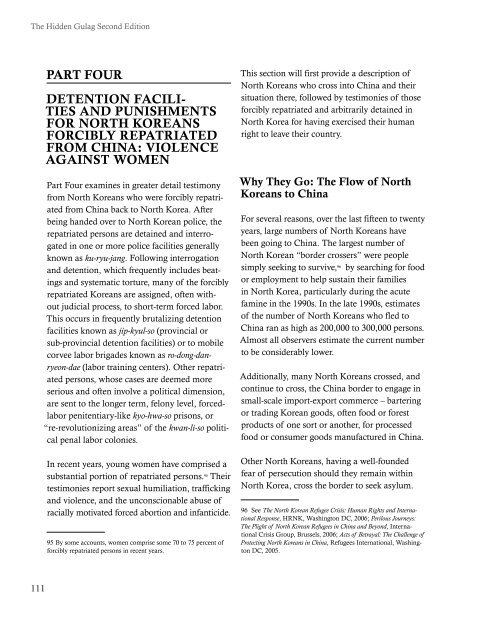The Hidden Gulag - US Committee for Human Rights in North Korea
The Hidden Gulag - US Committee for Human Rights in North Korea
The Hidden Gulag - US Committee for Human Rights in North Korea
Create successful ePaper yourself
Turn your PDF publications into a flip-book with our unique Google optimized e-Paper software.
<strong>The</strong> <strong>Hidden</strong> <strong>Gulag</strong> Second EditionPART FOURDETENTION FACILI-TIES AND PUNISHMENTSFOR NORTH KOREANSFORCIBLY REPATRIATEDFROM CHINA: VIOLENCEAGAINST WOMENPart Four exam<strong>in</strong>es <strong>in</strong> greater detail testimonyfrom <strong>North</strong> <strong>Korea</strong>ns who were <strong>for</strong>cibly repatriatedfrom Ch<strong>in</strong>a back to <strong>North</strong> <strong>Korea</strong>. Afterbe<strong>in</strong>g handed over to <strong>North</strong> <strong>Korea</strong>n police, therepatriated persons are deta<strong>in</strong>ed and <strong>in</strong>terrogated<strong>in</strong> one or more police facilities generallyknown as ku-ryu-jang. Follow<strong>in</strong>g <strong>in</strong>terrogationand detention, which frequently <strong>in</strong>cludes beat<strong>in</strong>gsand systematic torture, many of the <strong>for</strong>ciblyrepatriated <strong>Korea</strong>ns are assigned, often withoutjudicial process, to short-term <strong>for</strong>ced labor.This occurs <strong>in</strong> frequently brutaliz<strong>in</strong>g detentionfacilities known as jip-kyul-so (prov<strong>in</strong>cial orsub-prov<strong>in</strong>cial detention facilities) or to mobilecorvee labor brigades known as ro-dong-danryeon-dae(labor tra<strong>in</strong><strong>in</strong>g centers). Other repatriatedpersons, whose cases are deemed moreserious and often <strong>in</strong>volve a political dimension,are sent to the longer term, felony level, <strong>for</strong>cedlaborpenitentiary-like kyo-hwa-so prisons, or“re-revolutioniz<strong>in</strong>g areas” of the kwan-li-so politicalpenal labor colonies.In recent years, young women have comprised asubstantial portion of repatriated persons. 95 <strong>The</strong>irtestimonies report sexual humiliation, traffick<strong>in</strong>gand violence, and the unconscionable abuse ofracially motivated <strong>for</strong>ced abortion and <strong>in</strong>fanticide.95 By some accounts, women comprise some 70 to 75 percent of<strong>for</strong>cibly repatriated persons <strong>in</strong> recent years.This section will first provide a description of<strong>North</strong> <strong>Korea</strong>ns who cross <strong>in</strong>to Ch<strong>in</strong>a and theirsituation there, followed by testimonies of those<strong>for</strong>cibly repatriated and arbitrarily deta<strong>in</strong>ed <strong>in</strong><strong>North</strong> <strong>Korea</strong> <strong>for</strong> hav<strong>in</strong>g exercised their humanright to leave their country.Why <strong>The</strong>y Go: <strong>The</strong> Flow of <strong>North</strong><strong>Korea</strong>ns to Ch<strong>in</strong>aFor several reasons, over the last fifteen to twentyyears, large numbers of <strong>North</strong> <strong>Korea</strong>ns havebeen go<strong>in</strong>g to Ch<strong>in</strong>a. <strong>The</strong> largest number of<strong>North</strong> <strong>Korea</strong>n “border crossers” were peoplesimply seek<strong>in</strong>g to survive, 96 by search<strong>in</strong>g <strong>for</strong> foodor employment to help susta<strong>in</strong> their families<strong>in</strong> <strong>North</strong> <strong>Korea</strong>, particularly dur<strong>in</strong>g the acutefam<strong>in</strong>e <strong>in</strong> the 1990s. In the late 1990s, estimatesof the number of <strong>North</strong> <strong>Korea</strong>ns who fled toCh<strong>in</strong>a ran as high as 200,000 to 300,000 persons.Almost all observers estimate the current numberto be considerably lower.Additionally, many <strong>North</strong> <strong>Korea</strong>ns crossed, andcont<strong>in</strong>ue to cross, the Ch<strong>in</strong>a border to engage <strong>in</strong>small-scale import-export commerce – barter<strong>in</strong>gor trad<strong>in</strong>g <strong>Korea</strong>n goods, often food or <strong>for</strong>estproducts of one sort or another, <strong>for</strong> processedfood or consumer goods manufactured <strong>in</strong> Ch<strong>in</strong>a.Other <strong>North</strong> <strong>Korea</strong>ns, hav<strong>in</strong>g a well-foundedfear of persecution should they rema<strong>in</strong> with<strong>in</strong><strong>North</strong> <strong>Korea</strong>, cross the border to seek asylum.96 See <strong>The</strong> <strong>North</strong> <strong>Korea</strong>n Refugee Crisis: <strong>Human</strong> <strong>Rights</strong> and InternationalResponse, HRNK, Wash<strong>in</strong>gton DC, 2006; Perilous Journeys:<strong>The</strong> Plight of <strong>North</strong> <strong>Korea</strong>n Refugees <strong>in</strong> Ch<strong>in</strong>a and Beyond, InternationalCrisis Group, Brussels, 2006; Acts of Betrayal: <strong>The</strong> Challenge ofProtect<strong>in</strong>g <strong>North</strong> <strong>Korea</strong>ns <strong>in</strong> Ch<strong>in</strong>a, Refugees International, Wash<strong>in</strong>gtonDC, 2005.111



